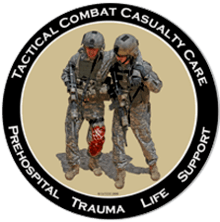Tactical combat casualty care

Tactical Combat Casualty Care (TCCC or TC3) is the standard of care in Prehospital Battlefield Medicine. The TCCC Guidelines are routinely updated and published by the Committee on Tactical Combat Casualty Care (CoTCCC), a component of the Joint Trauma System (JTS). TCCC was designed in the mid-'90s for the Special Operations medical community. Originally a Naval Special Warfare and USSOCOM Medical Research & Development initiative, TCCC developed battlefield appropriate and evidence-based casualty care based on injury patterns of previous conflicts. The original TCCC concept and guidelines were published in a Military Medicine Supplement in 1996.[1] The primary intent of TCCC is to reduce preventable combat death through a means that allows a unit to complete its mission while providing the best possible care for casualties. Now it is a DOD course, conducted by NAEMT.[2] TCCC or similar standards are used by most allied countries.[3]
The Committee on Tactical Combat Casualty Care (CoTCCC) was originally established by the US Special Operations Command in 2002 before shifting to the Naval Medical Education & Training Command in 2004. The CoTCCC was shifted again in 2007 as a standing subcommittee of the Defense Health Board (DHB). In 2012, the CoTCCC was moved to the DoD Joint Trauma System (JTS) where it currently resides. The CoTCCC has 42 voting members, who are specialized physicians, providers, and enlisted medical specialties from the U.S Army, U.S. Navy, U.S. Air Force, U.S. Marine Corps, and U.S. Coast Guard. The TCCC Working Group is larger group operating in conjunction with the CoTCCC consisting of non-voting members from throughout the DoD, US government agencies, civilian medical professionals, and partner nations.
TCCC Guidelines
The TCCC Guidelines are a set evidence-based best practice guidelines for battlefield trauma care have been developed over more than 14 years of war. Oversight of the TCCC guidelines is provided by the Committee on TCCC (CoTCCC).
- The current TCCC Guidelines are posted at https://deployedmedicine.com/tccc or at https://jts.amedd.army.mil/index.cfm/committees/cotccc
- The guidelines are also routinely available at:
- National Association of Emergency Medical Technicians: http://www.naemt.org/education/TCCC/guidelines_curriculum
- Journal of Special Operations Medicine: https://www.jsomonline.org/TCCC.html
- Defense Health Agency: https://www.deployedmedicine.com/market/11
- Joint Trauma System: http://www.usaisr.amedd.army.mil/10_jts.html
- Special Operations Medical Association: http://www.specialoperationsmedicine.org/Pages/tccc.aspx
Objectives of TCCC
The three objectives of TCCC are to provide lifesaving care to the injured combatant, to limit the risk of further casualties, and to help the unit achieve mission success.
- Treat injured combatants
- Limit the risk of further casualties
- Achieve mission success
Phases of Care
In TCCC prehospital battlefield care is divided into 3 phases:
Care Under Fire (CUF)
CUF is characterized as the care rendered to a casualty while still under effective fire. In this case, the first action is to return fire and take cover as fire superiority over the enemy is the best medicine to include the casualty remaining engaged if able. As an enemy is suppressed, casualties can move or be move to more secure positions. The only medical treatment rendered in CUF is stopping life-threatening hemorrhage (bleeding). TCCC actively endorses and recommends the early and immediate use of tourniquets to control massive external hemorrhage of limbs. All other treatment should be delayed until the casualty can be moved to a more secure and covered position and transitioned to tactical field care.
Tactical Field Care (TFC)
TFC is care rendered by first responders or prehospital medical personnel (primarily medics, corpsman, and pararescuemen) while still in the tactical environment. TFC is focused on assessment and management using the MARCH acronym.
- Massive hemorrhage is managed through the use of tourniquets, hemostatic dressings, junctional devices, and pressure dressings.
- The Airway is managed by rapid and aggressive opening of the airway to include cricothyroidotomy for difficult airways.
- Respirations and breathing is managed by the assessment for tension pneumothorax and aggressive use of needle decompression devices to relieve tension and improve breathing.
- Circulation impairment is assessed and managed through the initiation of intravenous access followed up by administration of tranexamic acid (TXA) if indicated, and a fluid resuscitation challenge using the principles of hypotensive resuscitation. TCCC promotes the early and far forward use of blood and blood products if available over the use colloids and discourages the administration of crystalloids such as normal saline (sodium chloride).
- Hypothermia prevention is an early and critical intervention to keep a traumatized casualty warm regardless of the operational environment.
Continued assessment and management in TFC includes treating penetrating eye trauma, assessing for traumatic brain injury or head injuries, treating burns, spling fractures, and dressing non-life-threatening wounds. TCCC promotes the early and aggressive use of analgesia (pain management) on the battlefield through the administration of Ketamine and/or Oral Tranmuccossal Fentanyl for casualties with moderate to severe pain. TCCC also promotes the early administration oral and intravenous or intramuscular antibiotics. The remainder of TFC care is dedicated is reassessment of injuries and interventions, documentation of care, communicating with tactical leadership and evacuation assets. TFC culminates with packaging a casualty for evacuation and then evacuating by available air, ground, or maritime assets.
Tactical Evacuation Care (TACEVAC)
TACEVAC care encompasses the same assessment and management included in TFC with additional focus on advanced procedures that can be initiated when en route to a medical treatment facility. The caveat of TACEVAC is the evacuation means and care may or may not be dedicated medical platforms such as a MEDEVAC helicopter. TACEVAC can also include the evacuation of casualties on available non-medical assets and the provision of care in such circumstances.
References
- ↑ Butler, F. K.; Hagmann, J.; Butler, E. G. (1996-08-01). "Tactical combat casualty care in special operations". Military Medicine. 161 Suppl: 3–16. ISSN 0026-4075. PMID 8772308.
- ↑ NAEMT cite
- ↑ Savage, E; Forestier, C; Withers, N; Tien, H; Pannell, D (2011). "Tactical combat casualty care in the Canadian Forces: lessons learned from the Afghan war". Can J Surg. 54: S118–23. doi:10.1503/cjs.025011. PMC 3322653. PMID 22099324.